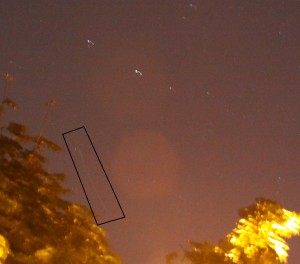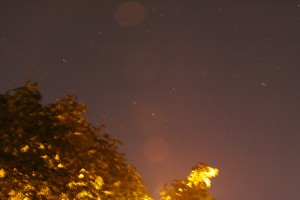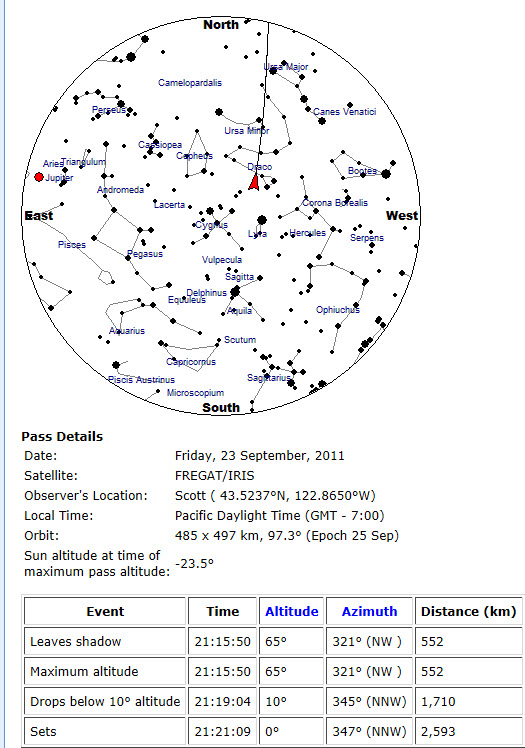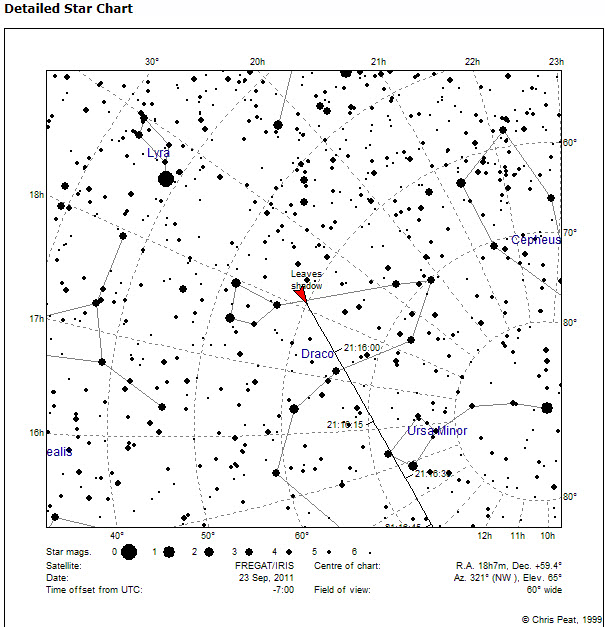A twitter friend @musicscott emailed me a picture he had taken Friday night of a region of the sky near Ursa Minor. In his picture he had a streak that he thought may have been a piece of the UARS satellite.
He provided me with the original as well:
The second image is really interesting, because it shows us the entire “little dipper” so we can really get a feel for where happened. Note that there’s some “jiggle” in the star images because Scott didn’t have time to set the timer on his camera, he had to hit the button manually and that shakes things a bit.
As it turns out, Scott knew very precisely when he took the picture (4:17:11 UTC), so with his help I looked into it. He gave me his precise location and time and managed to get a whole constellation into the picture. Here’s the email I sent him when I figured out what he had seen..
—————————–
After looking through this for a bit, I’ve convinced myself you did not see any part of UARS. The trajectory of UARS (if it was still around) was close to coming over you that day, but not as from the same direction as shown in your picture. Plus, as much as I tried I could not get the spacecraft to be overhead at 4:17:11 UTC on that date. I could get in the vicinity at 4:18, but the angle is wrong. If UARS were to have survived to get to your latitude, it’s path would have been in Ursa Minor, but would have looked like this from your location:
This is certainly in the vicinity, and within a minute, but the direction is off and the timing is off. This is a 10 second arc of what UARS would have shown from your spot. More than 1/2 of the full 10 second arc is off this picture. So it’s close, but it’s coming from the wrong direction really and the timing is off. Still though, it’s possible I screwed something up so I kept looking. This really is close.
So I went and looked at the Heavens-Above site. If you saw my previous posting here on this blog, you’ll see that just recently I saw a near-miss of the ISS from my back deck while I was talking on the phone with my brother. As luck would have it, in order to debug that event, I had to figure out what the other satellite is that I saw. So, I’ve recently had to do this. This is almost the same exact problem.
So I entered your location into Heavens-Above, and checked out what other satellites might have been visible that night. I did, and found this list:
The Fregat/IRIS object spans the right time (In-Cosmos-22 moves the wrong way), so I looked at how Heavens above displays it:
These show the path of that object that night. It’s obviously coming very close to Ursa Minor, so it’s worth a look. Note also that it starts at 65 degrees, very close to 70, as you mentioned.
I can get the satellite number from Heavens above, and put the satellite orbit elements into my software from an on-line database and propagate the orbit. Then I can look at what we’d see from your site.
I did that. I put my view to be from your location, at 4:17:11 UTC on the 24th. I made the satellite show 10 seconds of its pass from that point back (to match your exposure).
Here’s the picture (Ursa Minor Stars Labeled), with the 10 second arc show in purple.
This is a dead ringer for your picture.
You saw another satellite. A google search shows it to be a:
“a Russian technology demonstration satellite, was launched as a secondary payload on a Soyuz 2-1b rocket from Baikonur on 17 September 2009 at 15:55 UT. IRIS (Inflatable and Rigidizable Structure) consists of two inflatable panels mounted on the Fregat upper stage.”
——————–
I had a lot of fun interacting with Scott on this. He was a great sport about the whole thing, and really enjoyed the detective work we had to do to figure it out. I was very excited to be able to reproduce his view from that night. Great fun!






